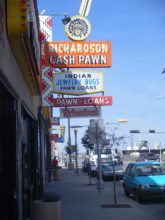Article
To obtain a cash loan by providing a material object as collateral. The act of pawning, also known as "hocking," usually via a pawnbroker at a pawn shop, has been in practice in the United States for over two hundred years. When a person needs money, she or he can go to a pawn shop and exchange a valuable item, such as jewelry, electronics, antiques, or musical instruments, in exchange for a cash loan. The object left behind is used as collateral against the cash loan. When customers are able, they can return to repay the loan, essentially buying back the collateral they left behind, often at interest. If borrowers can not repay their loan within a specified time, pawnbrokers sell the abandoned collateral accumulating in their shops in order to recoup their lost "investments," or the loans they extended to their clientele.
In the Southwest, pawnshops are often associated with reservation trading posts, as many early trading posts worked in a fashion similar to pawn shops. If customers were unable to pay cash for supplies, traders preferred obtaining objects as collateral rather extending lines of credit to their rural clientele. Cities such as Gallup, New Mexico, for example, became famous for their pawn shops, which were filled with high quality Navajo textiles and Zuni silversmithing. The flip side of pawn shops, trading posts, and contemporary businesses such as "payday loan" lenders is that, while they offer a "service," they are also often considered predatory. The rates of return on the loans extended always favor the broker, the trader, or the lender and never the individual who requests the loan. This sort of criticism demands that one consideration of the legacies of settler colonialism in the Southwest and elsewhere, including the imposition of cash economies on communities and cultures for whom the use and exchange of currency was an alien concept, yet a practice that was increasingly necessary. Having been forcibly removed from traditional life ways of sustenance and sustainability, traditional communities often struggled to negotiate a landscape where they could no longer provide for themselves unless they were able to purchase the goods, or versions of the goods, they used to provide for themselves. The commodification of their cultures and cultural artifacts has been facilitated, if not demanded, by institutions such as pawn shops and trading posts. So, while the ability to pawn an item for fast cash does provide a service for many folks on and off reservations, pawning items is usually a sign of desperation, or at least desperate times.
"Richardson's Trading Co. & Indian Cash Pawn, Gallup, New Mexico, August 29, 2008" by Bradley Gordon is licensed under CC BY.
Manuscripts
References
National Pawnbrokers Association.
N.d. Frequently Asked Questions. Http://www.nationalpawnbrokers.org/faq/, accessed March 30, 2015.
Woloson, Wendy
2012 A Brief History of the American Pawn Shop: Echoes. Bloomberg Business. Http://www.bloomberg.com/news/articles/2012-02-09/a-brief-history-of-the-ameri…, accessed March 30, 2015.
Woloson, Wendy
2009 In Hock: Pawning in America from Indipendence through the Great Depression. Chicago: University of Chicago Press.

